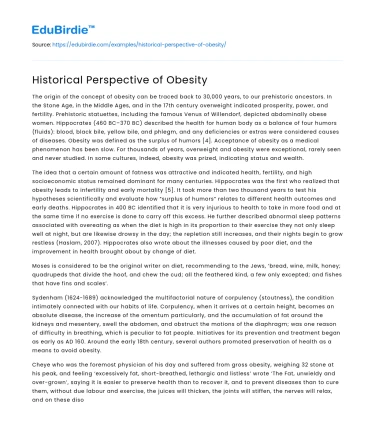The origin of the concept of obesity can be traced back to 30,000 years, to our prehistoric ancestors. In the Stone Age, in the Middle Ages, and in the 17th century overweight indicated prosperity, power, and fertility. Prehistoric statuettes, including the famous Venus of Willendorf, depicted abdominally obese women. Hippocrates (460 BC–370 BC) described the health for human body as a balance of four humors (fluids): blood, black bile, yellow bile, and phlegm, and any deficiencies or extras were considered causes of diseases. Obesity was defined as the surplus of humors [4]. Acceptance of obesity as a medical phenomenon has been slow. For thousands of years, overweight and obesity were exceptional, rarely seen and never studied. In some cultures, indeed, obesity was prized, indicating status and wealth.
The idea that a certain amount of fatness was attractive and indicated health, fertility, and high socioeconomic status remained dominant for many centuries. Hippocrates was the first who realized that obesity leads to infertility and early mortality [5]. It took more than two thousand years to test his hypotheses scientifically and evaluate how “surplus of humors” relates to different health outcomes and early deaths. Hippocrates in 400 BC identified that it is very injurious to health to take in more food and at the same time if no exercise is done to carry off this excess. He further described abnormal sleep patterns associated with overeating as when the diet is high in its proportion to their exercise they not only sleep well at night, but are likewise drowsy in the day; the repletion still increases, and their nights begin to grow restless (Haslam, 2007). Hippocrates also wrote about the illnesses caused by poor diet, and the improvement in health brought about by change of diet.
Save your time!
We can take care of your essay
- Proper editing and formatting
- Free revision, title page, and bibliography
- Flexible prices and money-back guarantee
Moses is considered to be the original writer on diet, recommending to the Jews, ‘bread, wine, milk, honey; quadrupeds that divide the hoof, and chew the cud; all the feathered kind, a few only excepted; and fishes that have fins and scales’.
Sydenham (1624-1689) acknowledged the multifactorial nature of corpulency (stoutness), the condition intimately connected with our habits of life. Corpulency, when it arrives at a certain height, becomes an absolute disease, the increase of the omentum particularly, and the accumulation of fat around the kidneys and mesentery, swell the abdomen, and obstruct the motions of the diaphragm; was one reason of difficulty in breathing, which is peculiar to fat people. Initiatives for its prevention and treatment began as early as AD 160. Around the early 18th century, several authors promoted preservation of health as a means to avoid obesity.
Cheye who was the foremost physician of his day and suffered from gross obesity, weighing 32 stone at his peak, and feeling ‘excessively fat, short-breathed, lethargic and listless’ wrote ‘The Fat, unwieldy and over-grown’, saying it is easier to preserve health than to recover it, and to prevent diseases than to cure them, without due labour and exercise, the juices will thicken, the joints will stiffen, the nerves will relax, and on these disorders, chronical distempers, and a crazy old age must ensue.
Ricketson in 1806 emphasized that obesity is a gradually acquired, hidden disease and can cause death as a result of over-eating. Thomas (1811) not only noted the presence of fat, but the site of body where fat accumulates in cases of diabetes, highlighting dangerous metabolically active visceral fat; Fat within the thorax, abdomen, and pelvis, in some instances has been entirely converted into a gelatinous-like matter of an amber colour. He also described respiratory and other disorders specifically related to abdominal obesity.
Banting in 1864 was the first one to write the commercially available diet programme, knowing of the breathlessness, joint pains that obesity caused, often then known as ‘gout’. Severe attack of angina pectoris, accompanied with vomiting and sweating was described by Osler (1897) a physician, in his case study of an obese man aged 55 who had attacks of severe pain in the region of the heart.
Obesity was conceived as corpulency and its deposition, the “apples” and “pears” of android and gynoid obesity were first described with its risk factors by French Physician Vague in 1947.
The Indian surgeon Sushruta (6th century BCE) related obesity to DM and heart disorders and recommended physical work to cure obesity and its side effects (6). For most of human history, mankind struggled with food scarcity (7) and therefore obesity has historically been viewed as a sign of wealth and prosperity. It was common among high officials in Europe in the Middle Ages and the Renaissance (8).
Obesity likely began with the advent of agriculture 12,000 years ago. Food surpluses and the relatively sedentary lifestyle on settlements made overconsumption possible for the first time in human history. Another factor was the rise of processed foods with the invention of the steel roller mills in the late 19th century. The evolution of the human diet over the past 10,000 years from a Paleolithic diet to our current modern pattern of intake has resulted in profound changes in feeding behavior. Shifts have occurred from diets high in fruits, vegetables, lean meats, and seafood to processed foods high in sodium and hydrogenated fats and low in fiber.






 Stuck on your essay?
Stuck on your essay?

